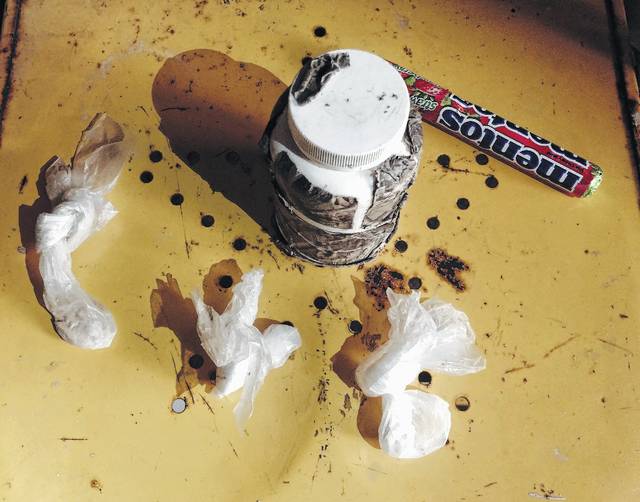
Highland County emergency agencies have already responded to more overdose calls so far this year than all of last year, and drug fatalities are on track to do the same, according to county officials.
Corp. Scott Miller, dispatch coordinator at the sheriff’s office, recently created a report tracking overdose dispatch totals year by year dating back to 2012, including statistics from Paint Creek Joint EMS/Fire District, which covers Hillsboro, Greenfield, and a large area of Highland County, as well as fire and EMS stations from around the county.
Most of the departments experienced a steady increase from 2012-2015, with Paint Creek handling the most overall since it covers the largest area of the county.
According to the report, Paint Creek responded to 38 overdose calls in 2012, 56 in 2013, 80 in 2014 and 84 in 2015.
Overdose calls increased dramatically for Paint Creek in 2016 when the department responded to 131 over the course of the year.
But this year, as of July 31, Paint Creek had already responded to 139 overdose calls, surpassing last year’s numbers with five months still left in the year.
Including Paint Creek, Highland County emergency workers were called to 92 overdoses in 2012, 101 in 2013, 105 in 2014 and 105 in 2015.
In 2016, the total rose to 170, and so far this year, EMS personnel have already responded to 176 overdose calls throughout the county.
Even though the police departments in Hillsboro and Greenfield have their own dispatchers, all EMS runs are made through dispatches from the sheriff’s office, so Miller’s stats are accurate for all overdose dispatches in the county.
But even though the report is as comprehensive as dispatch systems allow, Miller said the report doesn’t paint a complete picture of overdoses in Highland County, since it only includes calls that were initially reported as overdoses. For example, a call may have come in reporting an unresponsive person when the actual cause was an overdose.
And while not all the overdoses ended with a fatality, overdose deaths are on track to top last year’s numbers as well.
Contacted Friday, Highland County Coroner Dr. Jeff Beery could not give exact numbers on overdose deaths so far this year because he was not in his office, but he said Highland County is already set to beat last year’s record highs.
“Yeah, it’s going to,” the doctor said. “Unless we don’t have a single overdose the rest of the year, it’ll be a tie, but I’m not holding my breath over that. I’m afraid they’re going to continue.”
A report released by the coroner’s office earlier this year showed 16 people died of drug overdoses in 2016, the majority being from heroin, fentanyl or a mixture of the two.
“Last year was a record year,” Beery said.
This year, Beery said he’s noticed a disturbing amount of deaths suspected to have been caused by carfentanil intoxication. Carfentanil is an opiate roughly 8,000 times more potent than heroin, according to Beery.
Carfentanil, normally used as a tranquilizer for large animals such as elephants, has been increasingly found in heroin sold on the street, Beery said, and most recently is suspected to have killed at least four people here since April.
“There’s been a shift,” he said. “If you look at last year’s stats, you can see heroin is huge, along with other drugs, methamphetamine and cocaine, but as of April, the shift went to carfentanil.”
Beery said toxicology reports are pending in a number of suspected carfentanil overdoses in Highland County, and he expects more to come sooner rather than later.
“I think there are four or five confirmed already,” he said, “but there will be more… The carfentanil is huge. It’s unprecedented.”
According to Beery, carfentanil is a game-changer when it comes to immediate treatment due to its potency.
“It’s much harder to treat the overdose… than it would be with heroin, because it’s so much more (opioid inhibitor) than heroin,” Beery said. “It’s a bigger expense in resuscitation, because it takes a lot more medicine and a lot more effort, even after it’s reversed and it looks like the patient’s better.”
Beery said overdose victims often leave the hospital against doctors’ recommendations and can slip back into overdose symptoms again when the effects of naloxone wear off.
Beery said that he never thought he would see drugs kill so many people. When he began investigating deaths in 1999 and 2001, Beery said, a leading cause of death was automobile accidents.
Now, with overdose rates rising exponentially, Beery said he wonders where it all will end, especially since harder drugs seem to make bigger profits.
“It’s illogical to some that a dealer would sell a deadly drug,” Beery said. “You’d think, ‘Well, he’s killing his customers,’ but the profits are so great they don’t care they’re killing a customer, and the addicts are so desperate they’ll do anything to get the high.”
Reach David Wright at 937-402-2570, or on Twitter @DavidWrighter.


